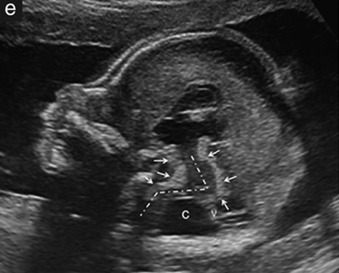Abstract
Walker-Warburg syndrome is a rare, lethal congenital diffuse neurodysplasia, characterized by variable cerebral and ocular abnormalities. Cerebral abnormalities include ventriculomegaly, encephalocele, and Dandy-Walker malformation. Other features include varied ocular findings in the posterior or anterior segments of the eye or in both. Principal diagnostic criteria are lissencephaly, cerebellar and ocular abnormalities, and congenital muscular dystrophy. Recurrence of Walker-Warburg syndrome in siblings, especially in consanguineous families, suggests an autosomal recessive mode of inheritance. Several genes have been implicated with considerable heterogeneity. Approximately 20% of patients have mutations in the protein O -mannosyltransferase 1 and 2 ( POMT1 and POMT2 ) genes. Prenatal diagnosis is based on typical ultrasound findings in the setting of a family history of the disorder. Genetic counseling should be offered to parents; amniocentesis should be recommended to exclude aneuploidy and to test for mutations in families that carry known mutations. Clinical manifestations at birth include generalized hypotonia, muscle weakness, developmental delay, mental retardation, and occasional seizures. Laboratory investigations usually show elevated creatine kinase, and muscle pathology reveals a myopathic or dystrophic pattern and altered alpha-dystroglycan. Infants often die within the first few months of life, with almost all affected children dying by age 3 years. No specific treatment is available, and management is supportive and preventive.
Keywords
cerebellar abnormalities, congenital muscular dystrophy, Dandy-Walker malformation, encephalocele, lethal, lissencephaly, neurodysplasia, ocular abnormalities, ventriculomegaly
Introduction
Walker-Warburg syndrome (WWS) is a rare, lethal congenital diffuse neurodysplasia, characterized by variable ocular and cerebral abnormalities. Cerebral findings include ventriculomegaly, encephalocele, and Dandy-Walker malformation. Ocular findings are varied, may occur in the posterior or anterior segments of the eye, or both, and include microphthalmia, congenital cataracts, corneal opacities, nonreactive pupils, iris synechiae, optic disk colobomas, and retinal dysplasia or detachment.
Disease
Definition
The principal morphologic diagnostic criteria of WWS are lissencephaly, cerebellar and ocular abnormalities, and congenital muscular dystrophy.
Prevalence and Epidemiology
WWS is a rare disease with a worldwide distribution. Although the overall incidence is unknown, a survey in Italy reported an incidence of 1.2 : 100,000 live births. WWS has been noted to recur in siblings, especially in consanguineous families, suggesting an autosomal recessive mode of inheritance.
Etiology and Pathophysiology
Several genes have been implicated in the etiology of WWS with considerable heterogeneity. Approximately 20% of patients have mutations in the protein O -mannosyltransferase 1 and 2 ( POMT1 and POMT2 ) genes, which are essential for muscle and neuronal development. The neurodysplasia has been attributed to failure of neuronal migration between the sixth and ninth weeks of gestation ; this may result from toxins, drugs, infections, radiation, or chromosomal aberrations. The ocular abnormalities are considered the result of abnormal differentiation of eye structures.
Manifestations of Disease
Clinical Presentation
A family history of the disorder or ultrasound (US) findings of lissencephaly, cerebral and cerebellar abnormalities, and ocular defects should raise suspicion of WWS prenatally. Clinical manifestations at birth include generalized hypotonia, muscle weakness, developmental delay, mental retardation, and occasional seizures. Laboratory investigations usually show elevated creatine kinase, and muscle pathology reveals a myopathic or dystrophic pattern and altered alpha-dystroglycan.
Imaging Technique and Findings
Ultrasound.
Although it is possible to look for a wide range of diagnostic signs in the neonate, it is not feasible to identify all the signs on US. Findings include ventriculomegaly ( Fig. 38.1 ), encephalocele ( Fig. 38.2 ), and Dandy-Walker malformation. Dandy-Walker malformation can be diagnosed at 14 weeks’ gestation, and ventriculomegaly can be seen by 15 to 17 weeks’ gestation. Lissencephaly cannot be reliably diagnosed until after 28 weeks, but a recent report describes making this diagnosis as early as 14 weeks. Lissencephaly may also be seen from a transvaginal view of the brain as a cobblestone appearance.











